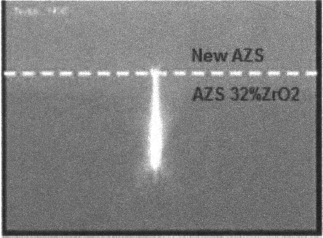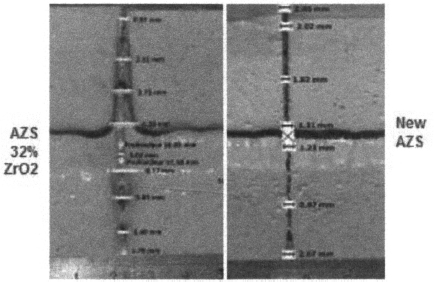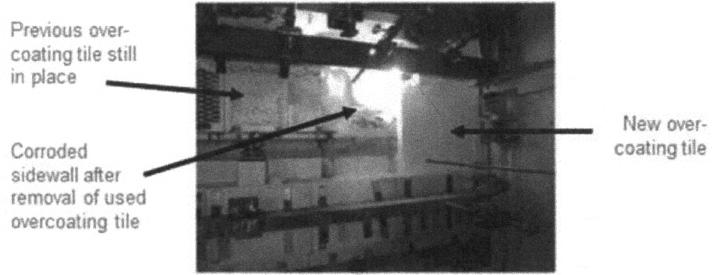Figure 1. Metal line area is one of the most exposed to chemical and thermo-mechanical stress

SEFPRO presents in this paper its new AZS for furnace over-coating at metal line. In this application, refractories are highly exposed to chemical and thermo-mechanical stresses. SEFPRO has developed a new refractory, the ER 2010 RIC® with an increased content of zirconia and an addition of yttrium, which modifies some specific properties that are critical for the target application. The main improvements are illustrated and are explained in this paper. This refractory is already industrialized, and deeply satisfies the customers.
For furnace over-coating application, refractories are highly exposed to chemical and thermo-mechanical stresses. Indeed, the area concerned by over-coating, that is to say sidewall metal line area, is one of the most exposed areas of the furnace. The exposure is due to the very high temperatures at metal line and to the important corrosion that is observed, as illustrated in Figure 1.
Figure 1. Metal line area is one of the most exposed to chemical and thermo-mechanical stress

The aim of side wall over-coating tiles is to protect this area from glass leakage. As a consequence, this allows the furnace to last longer.
SEFPRO tackles the challenge of metal line protection. Compared to the standard solution (AZS 32% zirconia) for the target application, the new ASZ brings out four main improvements:
Dynamic corrosion tests (“Merry Go Round”) have been realized. A sample of the new AZS has been compared to a sample of an AZS 32% zirconia. The samples were plunged in highly corrosive glass at high temperature. The volume difference was measured to compare both corrosion resistances. The results show an improvement of corrosion resistance of about 15%.
Lateral corrosion test has also been realized on samples of the two kinds of refractory studied above. The depth of the metal line has been measured. Results give a decrease of the metal line depth of about 30%.
Considering these results, the new AZS increases significantly the furnace lifetime since corrosion is reduced.
The joint closure is of major concern regarding the furnace lifetime. Indeed, if the joints are not perfectly closed at the operating temperature, glass can sneak into the joint and accelerate the corrosion.
A “joint closure test” has been realized on the new AZS and on an AZS 32% zirconia. The samples were heated up in a range of temperature that includes the metal line temperature and the zirconia phase transformation. As it can be seen on Figure 2, there is no joints’ opening for the new AZS. As a consequence, the corrosion at the joints is highly improved as it can be seen on Figure 3.
Figure 2. New AZS shows perfect joints’ closure

Figure 3. New AZS undergoes very little corrosion at the joints due to the perfect closure

Thermal shock resistance is also of major concern regarding the over-coating application since the installation process of over-coating tiles make the tiles undergo important thermal gradient in a short lap of time. Fig 4 shows the installation process on a furnace.
Figure 4. Installation of a tile for furnace hot over-coating replacement

Hence, thermal shock tests have been realized on the new AZS and on two other AZS (at 32% and 41% of zirconia). The samples were subject to a 1250°C temperature gradient shock for five consecutive times. The material’s elasticity was measured before and after the shocks, since the elasticity loss is one possible index linked to material damage. The results that are given in Figure 5 illustrate the fact that absolutely no cracks were observed on the new AZS after the test, whereas some cracks were observed on the AZS 41% of zirconia.
Figure 5. New AZS resists perfectly to thermal shock

Therefore, it can be stated that the new AZS is almost not sensitive to thermal shock damage.
As the metal line is an area of the furnace that undergoes many temperature variations, thermal cycling tests have been realized.
The samples used are the new AZS and two other AZS (at 32% and 41% of zirconia). The samples were subject to cycling at the most critical temperature range. The volume variation was measured, since it is linked to material damage risk in operation. As a result, none of the samples had cracks, and the new AZS has the lowest volume variation of the three samples with 1.9%. The other samples still have very low volume variation at about 2.5%.
Compared to the standard AZS with 32% of zirconia that is eligible for the same metal line over-coating application, two main changes are made on the new AZS. The zirconia content is increased from 32% to 36%, and some yttrium is added at a 3% proportion (Table 1).
Table 1. New AZS chemical composition (in weight %)

The increase of the zirconia rate improves the corrosion resistance by decreasing the dissolution rate of the refractory and by limiting the Marangoni effect at the interface refractory/glass/air.
Increasing zirconia could have led to a decrease of the refractory thermal conductivity. This would have been an issue for the air blowing efficiency in the cooling operating process at the metal line. However tests have been realized to check the thermal conductivity of the new AZS. Results, as shown in Figure 6, show that there is no decrease of the thermal conductivity compared to AZS 32% zirconia.
Figure 6. New AZS and AZS 32% zirconia have similar thermal conductivity

On the other hand, the addition of yttrium modifies completely the thermal expansion curve of zirconia in a very favorable configuration. The graph of thermal expansion is given in fig 8.
Figure 7. Effect of addition of yttrium changes on thermal expansion curve

There are two main consequences to this new thermal expansion curve:
Those two consequences were illustrated in the previous section where the improvements of the new AZS were experimentally checked.
SEFPRO has developed a new AZS that is perfectly adapted to metal line over-coating application. This new AZS is named ER 2010 RIC®. The product shows four main improvements: improved corrosion resistance with no degradation of thermal conductivity, improved joint closure, improved thermal shock resistance, and improved thermal cycling resistance. These improvements are directly linked to the increase of zirconia and the addition of yttrium. The product is industrialized since 2011. It has very successful feedback in operation. ER 2010 RIC fully satisfies SEFPRO customers, as longer furnace lifetime is expected.